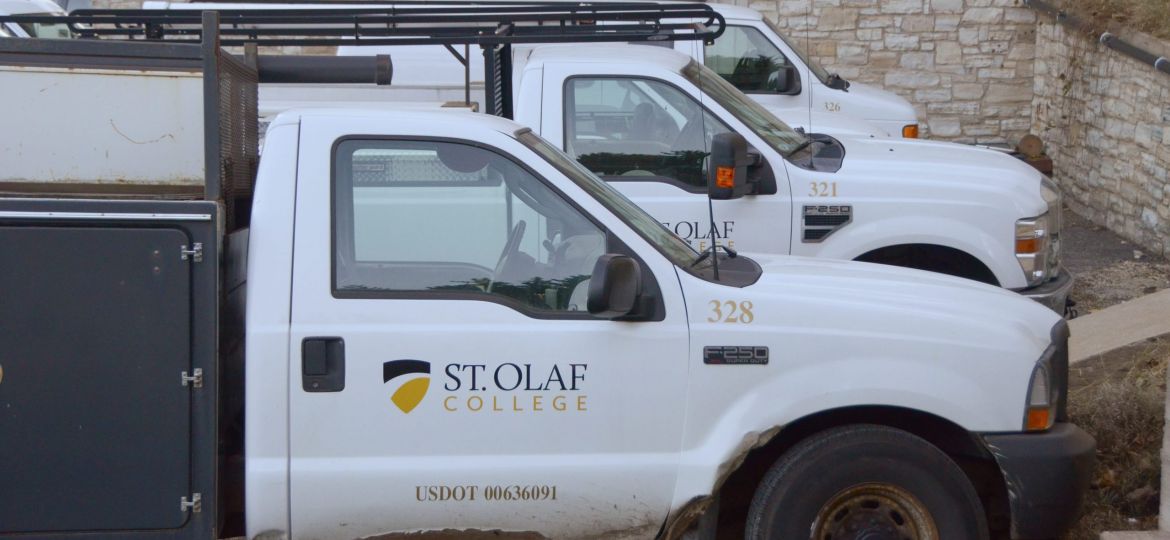
St. Olaf College has five miles of roads, 11 miles of sidewalks, 100 feet of elevation change and 300 acres of groomed campus. St. Olaf’s grounds crew tends to these massive swaths of land, caring for natural tracts and concrete thoroughfares alike.
Broadly speaking, the grounds crew takes care of everything outdoors, from sidewalks and parking lots, to trees, shrubs and flower beds. The grounds crew is also responsible for composting, maintaining the athletic fields and natural lands, storm-water drainage and moving equipment across campus.
With winter on its way, the grounds crew’s work becomes more critical by the day. Many students will soon appreciate plowed sidewalks and salted roads on their way to class. Outdoor enthusiasts will enjoy groomed ski trails winding through the natural lands. The grounds crew has also taken part in recent preparations for Christmas Fest, moving equipment down to Skoglund and transforming grass fields into overflow parking space.
With a veteran staff of nine employees, some who have been at St. Olaf for over 20 years, the grounds crew possesses unique insights into the College’s past and future.
Some of this knowledge arises from odd, chance encounters with the College’s history. For instance, during the construction of Regents Hall, the builders and grounds crew uncovered timbers from an old chapel that had previously burned down and been buried.
“That’s one thing I’ve put together over the years, as we discover the hilltop of the campus has been modified by man for quite a while,” Assistant Director of Facilities Jim Fisher said.
Over the years, Fisher and the grounds crew have had to repeatedly accommodate sweeping overhauls of the campus’s buildings and layout. For example, the predecessor to the Center for Art and Dance (CAD) used to exist where Regents Hall currently stands. CAD used to be the Student Center – before Buntrock Commons was built – complete with a bowling alley, Cage and dining area. Tomson Hall was the science building, and parts of Christiansen Hall of Music housed administrative offices.
“The Buntrock parking lot was not a sheet, it was actually tiered down the hill,” Fisher said. “All the excavation from Buntrock Commons was pushed out to make a level parking lot rather than a tiered parking lot. What we see right now on St. Olaf campus has changed a lot in 25 years, let alone 150.”
There used to be a ski jump on the hill by Thorson Hall. Although it was taken down several decades ago, the footings remained and the hill stayed open for sledding, leading to some grisly accidents. One of Fisher’s first actions at St. Olaf was to close this hill to sledding by planting trees and foliage.
“It was just too tempting and too many trips to the emergency room with broken arms and broken noses, with students sliding down where the ski jump used to be. It was not very wide, but it was very steep,” Fisher said.
Grounds crew also has unique background knowledge regarding the renovation of Holland Hall.
“For the first 20-some-odd years here, I kept getting complaints that water was getting into the basement of the building, and when we started excavating we discovered that sometime in the 60s they bermed dirt up against the wall of Holland Hall,” Fisher said. This led to groundwater leaking into the building.
“That’s why there’s more, what appears to be more building exposed now, but it’s actually taken back more to the original flavor of what was there,” Fisher said. Reverting Holland Hall to its original design presented some logistical challenges. For instance, the original Holland Hall was not accessible, leading to the need for the long, drawbridge-esque pathway on the north side of the building.
According to Fisher, proper maintenance of the outdoor facilities has dramatically extended their lifespan.
“Doing proper maintenance on some of these things, the track for instance, the outdoor running track is 28 years old right now, and just by doing proper maintenance on it, that’s probably two to three times longer lived than most outdoor artificial running tracks,” Fisher said.
Fisher and the grounds crew foresee a number of renovations happening in the future. Most immediately, a number of dormitories need remodelling, although more drastic projects may be on the horizon.
“Buntrock is coming up on it’s 20th birthday sometime not too far down the road, just a couple more years here. It’s going to need some remodelling,” Fisher said.

